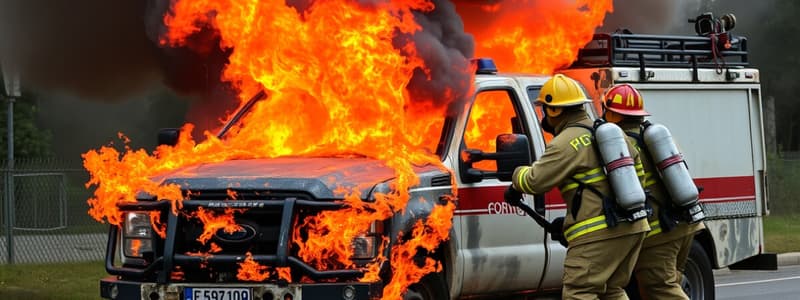Podcast
Questions and Answers
What is the minimum size of hose line required to initiate an attack on a vehicle fire?
What is the minimum size of hose line required to initiate an attack on a vehicle fire?
- 3 inch handline
- 1 ¾ inch handline (correct)
- 2 inch handline
- 1 inch handline
When approaching a vehicle fire, what personal protective equipment (PPE) is necessary?
When approaching a vehicle fire, what personal protective equipment (PPE) is necessary?
- Full PPE and SCBA with facepiece (correct)
- Casual clothing with a fireproof jacket
- No PPE needed
- Only helmet and gloves
What is the recommended angle from which to initiate a fire attack on a vehicle?
What is the recommended angle from which to initiate a fire attack on a vehicle?
- 30-degree angle
- 45-degree angle (correct)
- 180-degree angle
- 90-degree angle
What should be the first priority when applying water to a vehicle fire?
What should be the first priority when applying water to a vehicle fire?
What should be applied to a vehicle to prevent it from rolling during a fire attack?
What should be applied to a vehicle to prevent it from rolling during a fire attack?
Flashcards are hidden until you start studying
Study Notes
Fire Attack Protocol
- Minimum hose size for vehicle fire attack is 1¾ inch handline.
- Complete Personal Protective Equipment (PPE) and Self-Contained Breathing Apparatus (SCBA) with facepiece must be worn before approaching the vehicle.
- Attack should be initiated from a 45-degree angle to maximize the reach of the fire stream and effectively extinguish the fire.
- First application of water targets the passenger compartment to extinguish flames or protect occupants.
- An "all clear" must be obtained before proceeding with further actions.
- Wheel chocks are crucial to prevent vehicle movement during the fire attack.
- Hand tools can assist in gaining access to restricted areas within the vehicle as needed.
Studying That Suits You
Use AI to generate personalized quizzes and flashcards to suit your learning preferences.




